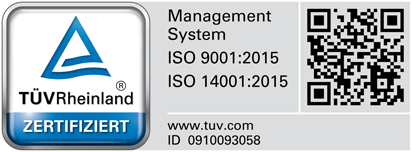sales@lufapak.de +49 2631/384-0 Contactform
SSCC (serial shipping container code)
A shipping unit number (SSCN) is a unique, standardised identification number that is assigned to an individual shipping unit. This number enables parcels or pallets to be uniquely identified and traced within the supply chain. The SSCC number plays a crucial role in logistics by ensuring that each unit can be correctly identified and tracked throughout the shipping process.
The SSCC is usually represented as a barcode on an SSCC label that is affixed to the shipping unit. This barcode can be read by scanners along the supply chain to monitor the movement and status of the unit. By using SSCCs, companies can reduce errors, increase efficiency and ensure precise traceability of their shipments.
The importance of SSCCs
SSCCs are crucial in logistics as they offer a variety of benefits for shipping and tracking goods. By uniquely identifying each shipping unit, companies can ensure that each shipment is accurately monitored and tracked throughout the transport process.
Advantages of the SSCC:
- Unique identification: each SSCC number is unique and allows shipping units to be uniquely identified. This prevents mix-ups and ensures that each unit can be correctly assigned.
- Improved traceability: Thanks to the SSCC, companies can track the location and status of each shipping unit in real time. This is particularly important for maintaining a transparent supply chain and for quickly localising goods in the event of problems.
- Increased efficiency: The use of NVE labels and barcodes enables automated data capture and processing. This reduces manual effort and minimises the risk of human error, resulting in more efficient logistics overall.
- Error reduction: The standardised and automated identification and tracking of shipping units significantly reduces errors such as lost or incorrectly delivered parcels.
- Customer satisfaction: Precise and reliable tracking of shipments improves transparency and communication with customers. Customers can track their orders in real time, leading to greater satisfaction and confidence in the service.
By implementing SSCC in their logistics processes, companies can not only optimise their internal processes, but also improve the quality of their customer service. This makes the SSCC an indispensable tool in modern logistics.
Structure of a SSCC number
A SSCC number consists of a defined structure. This structure is designed to uniquely identify each shipping unit and ensure that the number is interpreted consistently in different systems and across different logistics partners.

Components of a SSCC number:
- Base number: The SSCC begins with a base number that is assigned to the company. This base number ensures that the following information can be assigned to the specific organisation.
- Serial number: The basic number is followed by a serial number that is unique for each shipping unit within a company. This serial number is assigned consecutively in order to uniquely identify each unit.
- Check digit: A check digit at the end of the SSCC number is used to validate the number. It is calculated algorithmically and helps to recognise errors when entering or transmitting the number.
Example of a SSCC number
Let’s imagine an SSCC number looks like this:
1234567 8901234 5
- 1234567: This is the basic number of the company.
- 8901234: This is the sequential serial number for a specific shipping unit.
- 5: This is the check digit used to ensure the integrity of the number.
Representation as a barcode
The SSCC number is often displayed as a barcode on an SSCC label. This barcode can be read by scanners along the supply chain, which enables the number to be recorded quickly and accurately.
Advantages of the structured SSCC number:
- Uniqueness: the combination of base number, serial number and check digit ensures that each SSCC number is unique worldwide.
- Error prevention: The check digit helps to prevent errors during data entry as incorrect numbers can be recognised immediately.
- Compatibility: The standardised structure enables seamless integration into different IT and logistics systems, which facilitates collaboration between different partners.
Thanks to this structured design, the SSCC number ensures that each shipping unit can be precisely identified and tracked, which increases efficiency and reliability in logistics.
Areas of application of the shipping unit number
The shipping unit number is used in a variety of logistics processes and industries. Its main aim is to improve traceability and efficiency in the supply chain.
Transport and forwarding companies
Transport and forwarding companies use the SSCC to uniquely identify and track individual parcels, pallets or containers. This makes it easier to manage shipments, as each logistics hub can record the shipping units quickly and accurately. The use of SSCC minimises the risk of mix-ups and losses during transport and ensures transparent shipment tracking.
Warehousing and distribution
In warehouses and distribution centres, SSCC plays a key role in the management of incoming and outgoing goods. Thanks to the unique identification of each shipping unit, stock levels can be managed more efficiently. The SSCC also simplifies inventory processes, as each unit can be scanned and recorded quickly.
E-commerce and retail
In e-commerce and retail, SSCC helps to optimise order processing. Once an order is placed, each shipping unit receives a SSCC number that is tracked throughout the process – from the warehouse to delivery to the customer. This enables seamless tracking of the shipment and improves customer satisfaction through transparent delivery status information.
Manufacturing and production
In manufacturing and production, NVE ensures efficient management of raw materials, semi-finished and finished products. Each shipping unit can be tracked through the production chain, enabling precise planning and control of the manufacturing processes. NVE also helps with traceability in the event of quality problems or product recalls.
Pharmaceutical industry
Product traceability is particularly important in the pharmaceutical industry. NVE ensures that every batch of medicines and medical products remains clearly identifiable throughout the entire supply chain. This supports compliance with legal regulations and facilitates traceability in the event of product recalls.
Automotive industry
The automotive industry uses NVE to manage components and spare parts. By uniquely identifying each shipping unit, the supply chain can be optimised and the availability of parts monitored in real time. This reduces downtime and supports just-in-time production.
The NVE label: labelling and use
The SSCC label is a central element in logistics that displays the shipping unit number visibly and machine-readably on each shipping unit. It plays a crucial role in the tracking and management of consignments by enabling fast and error-free identification.
Function of the NVE label
- Unique identification: It ensures that each shipping unit can be clearly identified by its unique SSCC number.
- Machine readability: By displaying the SSCC as a barcode or QR code, the number can be quickly and accurately read by scanners.
- Traceability: It allows the shipping unit to be tracked throughout the supply chain, from manufacture to final delivery.
Components of a SSCC label
- SSCC number: The unique identification number of the shipping unit, usually in the form of a barcode or QR code.
- Plain text: The SSCC number is also shown in plain text on the label to make it manually readable.
- Additional information: Optionally, further logistical information such as the weight, number of items or specific handling instructions can be noted on the label.
Attachment of the SSCC label
The correct attachment of the SSCC label is crucial for its functionality.
- Positioning: The label should be placed in a clearly visible position on the shipping unit, preferably on a flat surface to facilitate scanning.
- Security: It should be ensured that the label adheres firmly and is not damaged or detached during transport.
- Multiple labelling: For larger packaging units, it may be useful to apply the label on several sides to increase visibility and accessibility.
Use of the NVE label in practice
In practice, the SSCC label is used in various logistics processes:
- Incoming goods: when the shipping unit arrives at the warehouse, the SSCC label is scanned to confirm receipt and record the unit in the system.
- Warehouse management: During storage, the label enables simple identification and inventory of the shipping unit.
- Picking and despatch: During picking and despatch, the SSCC label is scanned again to verify the unit and update its status in the system.
- Delivery and receipt: At the destination, the SSCC label can be scanned to confirm delivery and finalise tracking.
Conclusion: The relevance of SSCCs in modern shipping
The SSCC has established itself as an indispensable tool in modern logistics. Its ability to uniquely identify each shipping unit and track it throughout the supply chain brings numerous benefits that significantly increase both the efficiency and transparency of logistics processes.
The SSCC is much more than just an identification number. It is a key element of modern logistics systems that promotes efficiency, accuracy and customer satisfaction. With the ongoing development and increasing demands on supply chains, the role of SSCCs in the logistics industry will continue to grow in importance. Companies that utilise the benefits of SSCC will be better able to meet the challenges of modern logistics and strengthen their competitiveness.
Contact us now and get advice

